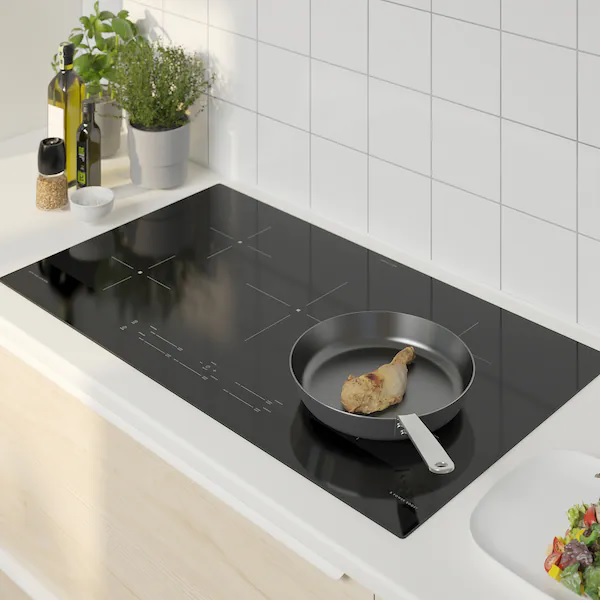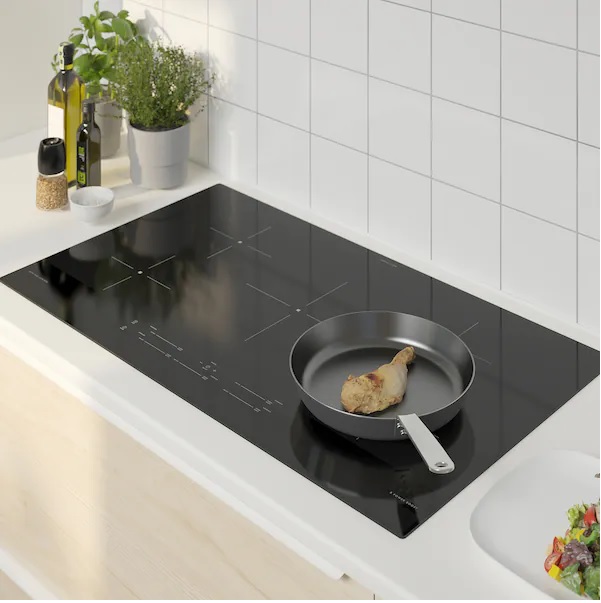SAMFÄLLD

IMPORTANT SAFETY INFORMATION
Read all instructions before using this appliance.
This manual contains important safety symbols and instructions. Please pay atten- tion to these symbols and follow all instructions given.Do not attempt to install or operate your appliance until you have read the safety precautions in this manual. Safety items throughout this manual are labeled with a WARNING or CAUTION statement based on the risk type.
Warnings and important instructions appearing in this guide are not meant to cover all possible conditions and situations that may occur. Common sense, caution, and care must be exercised with installing, maintaining, or operating your appliance.
DEFINITIONS
This is the safety alert symbol. It is used to alert you to potential personal injury hazards. Obey all safety messages that follow this symbol to avoid possible injury or death.
Note: Indicates a potentially hazardous situation which, if not avoided, may result in death or serious injury.
IMPORTANT SAFETY INFORMATION
IMPORTANT INSTRUCTIONS FOR UNPACKING AND INSTALLATION GROUNDING INSTRUCTIONS
Remove all tape and packaging before using the appliance. Destroy the carton and plastic bags after unpacking the appliance. Never allow children to play with packaging material. Do not remove the wiring label and other literature attached to the appliance. Do not remove model/serial number plate.
Cold temperatures can damage the electronic control. When using this appliance for the first time, or when the appliance has not been used for an extended period of time, be sure the appliance has been in temperatures above 32ºF (0ºC) for at least 3 hours before turning on the power to the appliance.
Never modify or alter the construction of the appliance by removing the leveling legs, panels, wire covers, anti-tip brackets/ screws, or any other part of the appliance. Be sure to have an appropriate foam-type fire extinguisher available, visible, and easily accessible located near the appliance.
Proper Installation—Be sure your appliance is properly installed and grounded by a qualified technician. In the United States, install in accordance with the National Fuel Gas Code ANSI Z223.1/NPFA No. 54, latest edition and National Electrical Code NFPA No. 70 latest edition, and local electrical code requirements.In Canada, install in accordance with CAN/CGA B149.1 and CAN/ CGA B149.2 and CSA Standard C22.1, Canadian Electrical code, Part 1-latest editions and local electrical code requirements.
Install only per installation instructions provided in the literature package for this appliance.
For personal safety, this appliance must be properly grounded. For maximum safety, the power cord must be securely connected to an electrical outlet or junction box that is the correct voltage, is correctly polarized and properly grounded, and protected by a circuit breaker in accordance with local codes.
It is the personal responsibility of the consumer to have the appropriate outlet or junction box with the correct, properly grounded wall receptacle installed by a qualified electrician. It is the responsibility and obligation of the consumer to contact a qualified installer to assure that the electrical installation is adequate and is in conformance with all local codes and ordinances.
See the installation instructions packaged with this appliance for complete installation and grounding instructions.
Caution
When heating fat or grease, watch it closely. Grease may catch fi re if it becomes too hot.Do not use water or flour on grease fi res. Smother fi re or flame or use dry chemical or foam-type extinguisher. Cover the fi re with a pan lid or use baking soda. Use dry potholders. Moist or damp potholders on hot surfaces may result in burns from steam. Do not let potholders touch hot cooking areas. Do not use towels or other bulky cloths.
Do not heat unopened food containers – Build-up of pressure may cause container to burst and result in injury. Wear proper apparel – Loose-fi tting or hanging garments should never be worn while using the appliance. Do not let clothing or other flammable materials contact hot surfaces.
Do not touch surface burners or elements, areas near these burners or elements, interior surfaces of the oven, or the warmer drawer (if equipped). Surface burners and elements may be hot even though they appear cool. Areas near surface burners and elements may become hot enough to cause burns. During and after use, do not touch, or let clothing or other flammable materials touch these areas until they are cool. These areas may include the cooktop, surfaces facing the cooktop, oven vent areas, oven door, and oven window.
COOKTOP
Improper cookware may break due to sud- den changes in temperature. Check the cookware manufacturer’s recommendations for cooktop use.
Use proper pan size – This appliance is equipped with one or more surface units of different sizes. Select cookware with flat bottoms that match the surface unit size. Using the proper cookware on the cooking area will improve efficiency.
Never leave surface elements unattended. Boil-overs may cause smoking and greasy spills that may ignite. A pan that has boiled dry could be damaged and may damage the cooktop. When you are flaming foods under a ventilating hood, turn on the fan.
Know which knob or key controls each surface heating area. Place cookware with food on the cooking area before turning it on. Turn the cooking area off before remov- ing the cookware.
Cookware handles should be turned inward and not extend over adjacent surface elements. — To reduce the risk of burns, ignition of flammable materials, and spillage due to unintentional contact with the uten- sil, the handle of the cookware should be positioned so that it is turned inward, and does not extend over other cooking areas.
Glazed cooking utensils — Only certain types of cookware are suitable for cook top service and must be magnetic to work properly on the induction zones. Check the manufacturer’s recommendations for cook top use to ensure that the cookware is compatible with induction cooking.
IMPORTANT INSTRUCTIONS FOR GLASS AND CERAMIC COOKTOPS
Do Not Clean or Operate a Broken Cooktop. If cooktop should break, cleaning solutions and spillovers may penetrate the broken cooktop and create a risk of electric shock. Contact a qualified technician immediately. Clean cooktop glass with caution. If a wet sponge or cloth is used to wipe spills on
a hot cooking area, be careful to avoid a steam burn. Some cleaners can produce harmful fumes if applied to a hot surface.
Avoid scratching the cooktop glass with sharp objects.
IMPORTANT INSTRUCTIONS FOR CLEANING YOUR APPLIANCE
Clean the appliance regularly to keep all parts free of grease that could catch fire. Do not allow grease to accumulate. Greasy deposits in the fan could catch fire. Always follow the manufacturer’s recommended directions for use of kitchen cleaners and aerosols. Be aware that excess residue from cleaners and aerosols may ignite causing damage and injury.
Clean ventilating hoods frequently – Grease should not be allowed to accumulate on hood or filter. Follow the manufacturer’s instructions for cleaning vent hoods.
IMPORTANT INSTRUCTIONS FOR SERVICE AND MAINTENANCE
Do not repair or replace any part of the appliance unless specifically recommended in the manuals. All other servicing should be done only by a qualified technician. This re- duces the risk of personal injury and dam- age to the appliance. Always contact your dealer, distributor, service agent, or manufacturer about problems or conditions you do not understand.
Ask your dealer to recommend a qualified technician and an authorized repair service. Know how to disconnect the power to the appliance at the circuit breaker or fuse box in case of an emergency.
What is Electromagnetic Induction?
Induction cooking uses electromagnets to create heat in compatible cookware.
Below each cooking zone on an induction cooktop, there is a copper coil. When the cooking zone is turned on, the electricity turns the coil into a type of magnet that heats metal cookware in the cooking zone.
Induction Features
Because heat starts in the cookware instead of the cooktop, induction offers several advantages.
Fast Heating: Cookware will heat up faster than on a conventional electric cooktop. Pay close attention to avoid scorching food when starting to cook. You may need to use a lower setting for cooking food than you are used to.
Precise Control: The heat going into the cookware will change immediately when you change the set- ting of the cooking zone.
Even Heating: Cookware will typically heat more evenly on an induction cooktop, so you are less likely to have hot or cool spots in the cookware.
Cooler Cooktop: An induction cooktop will be cooler when you remove the cookware than a conventional electric cooktop would be. Because the cooktop doesn’t get as hot, you are not as likely to get burned. Spills are also less likely to cook onto the surface, making clean-up easier.
Energy Efficiency: Induction cooking wastes less energy than a conventional cooktop, so it uses less electricity.
Preparation
Before using your cooktop for the first time, apply a ceramic cooktop cleaning cream (available in most hardware, grocery, and department stores) to the ceramic surface. Clean and buff with a clean paper towel. Cooktop cleaning creams leave a protective finish on the glass that will make cleaning easier when the cooktop is soiled from cooking and help prevent scratches and abrasions
Sounds
The magnetic field over the induction cooking zone may cause cookware to vibrate, creating a buzzing or humming noise. These sounds are not unusual, especially at high settings Cookware that is not perfectly flat on the bottom may vibrate slightly against the cooktop.


![]()


![]()
![]()
A loose handle may vibrate in its socket.
Multi-material cook- ware may allow small vibrations in its struc- ture
.![]()

![]()
![]()
Sounds are less likely to occur with heavier, higher quality cookware. An induction cooktop may also produce faint click- ing sounds from the electronic switches that maintain the desired cooking temperature. You may also hear a fan that cools the electronics inside the cooktop.
Using Proper Cookware
The size and type of cookware used will influence the heat setting needed for best cooking results. Be sure to follow the recommendations for using proper cookware as illustrated
To see if a piece of cookware will work on your induction cooktop, try to stick a magnet to it.
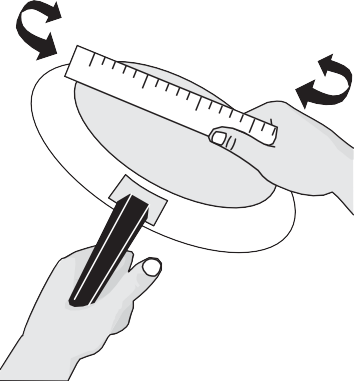
![]()
Cookware Material Types
Cookware material is especially important when using an induction cooktop. The cookware must contain magnetic iron or steel to work on an induction cooktop. Common materials for induction cookware include the following:
- Stainless Steel – Slow heat conductor with uneven cooking results. Durable, easy to clean, and resists staining. Some types of stainless steel will not work on an induction cooktop. Use the magnet test (see “Figure 4: Magnet test”) to check stainless steel cookware.
- Cast Iron – A slow heat conductor that retains heat very well. Cooks evenly once cooking temperature is reached.
- Porcelain-enamel on metal – Heating characteristics will vary depending on the base material. Porcelain-enamel on a compatible metal will work on an induction cooktop. Use the magnet test to check porcelain-enamel cookware.
To see if a piece of cookware will work on your induction cooktop, try to stick a magnet to it. If the magnet clings fi rmly to the bottom of the cookware, the cookware will work on your induction cooktop
The Magnet Test
To see if a piece of cookware will work on your induction cooktop, try to stick a magnet to it (see Figure 2).
If the magnet clings fi rmly to the bottom of the cookware, it will work on your induction cooktop. If the magnet clings weakly or not at all, the cookware will not heat up on your induction cooktop.
Caution:
Proper cookware on an operating induction cooking zone will heat up very quickly. If an empty piece of cookware is left on an operating induction cooking zone, the rapid change in temperature may warp or damage the cookware.
BEFORE SETTING SURFACE CONTROLS
Pan Sensing
Sensors beneath the cooktop surface require that certain cookware conditions be met before an induction cooking zone will operate. If a cooking zone is turned on and conditions are wrong, the setting in the zone display will flash.
|
|
|
|
Magnet Sticks
|
Magnet Falls
|
Minimum and Maximum Pan Size
Induction cooking zones require pans of proper size in order to activate. The cooktop graphics are guides to minimum and maximum pan size for each cooking zone.
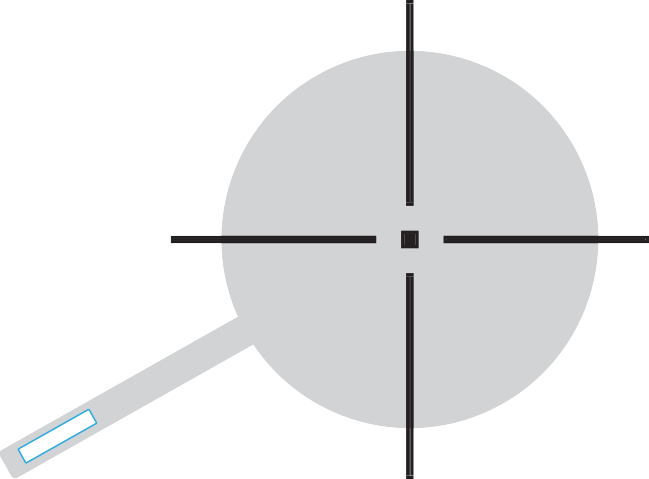
Good cookware size
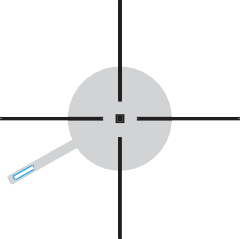
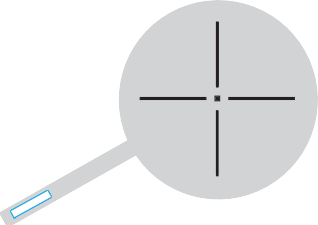
Cookware too small, Cookware too large
The inner ring on each cooking zone indicates the smallest pan size for the zone. If cook- ware is too small, the display will flash and the pan will not heat. Select a larger pan or use a different cooking zone.
The outer ring on the cooktop graphic indicates the largest pan size for that zone. Do not use pans with bottoms that extend beyond the outer circle of a cooking zone, as doing so may cause food to heat unevenly.
Correcting Pan Sensing Errors
It is recommended that you lower the requested power level setting before correcting a pan sens- ing error, then reset the zone to the desired power level. If conditions preventing operation are not corrected, the cooking zone will automatically turn off after two minutes.
Induction Controls
When turned on, an induction cooking zone will not get hot. The induction cooking zone creates heat in the cookware, not in the cooktop. Heat is not created unless there is an iron or steel object on the cooking zone.

Cooking Zone Setting Display
The setting display will show the setting for the cook zone.

If there is no cookware in the cook zone, the setting indicator will flash, and the magnet will not turn on. The indicator will also flash if the cookware in the zone is the wrong size, off-center, or non-magnetic.
Hot Surface Indicator
If the cooking zone becomes hot during cooking, the setting indicator will show a Hot Surface warning (H) when the zone is turned off. This warning will show until the cooking zone cools.
Cooktop Controls

- Lock: Lock the cooktop controls to prevent ac- cidental activation of cooking zones.
- Power: Press to turn on or turn off the cooktop.
- Cooking Zone Power Boil Indicator: Lights when the Power Boil feature is in use on the cooking zone.
- Cooking Zone Setting Indicator: Shows the setting of the Cooking Zone when it is running. Flashes when the Cooking Zone does not detect proper cookware. Shows a Hot Cooktop message(H) when the Cooking Zone is off but still hot.
- Cooking Zone On/Off: Activates the cooking zone when the cooktop is on.
- Cooking Zone Minimum (1): Sets the cooking zone to the minimum power level.
- Cooking Zone Set: Press or slide your finger on the line to select the desired cooking zone setting.
- Cooking Zone Maximum (Power Boost): Sets the cooking zone to Power Boil.
- Timer Indicator: Shows the time currently left on the timer.
- Reduce Time (-): Reduce the amount of time on the timer.
- Timer On/Off: Turn the countdown timer on or off.
- Increase Time (+): Increase the amount of time on the timer.
Induction surface cooking zones
To operate an induction cooking zone:
- Place correctly sized cookware on the cooking zone.
- Activate the cooking zone.
- If the cooktop is not on, press the Main Power key.
- Press the On/Off key for the desired cooking zone. If you just turned the cooktop on, this step can be skipped.
- Set the cooking zone to the desired level (refer to Table 1).
- Place your finger on the control and slide until the desired setting is indicated.
- Press Power Boost to set the zone to Power Boil.
- Press 1 to set the zone to its lowest setting.
- When cooking is complete, turn the induction cooking zone OFF by pressing its On/Off key or the Main Power key before removing the cook- ware. If all of the zones are off, the cooktop will automatically power off in 20 seconds.
Suggested induction cooking zone settings
Start most cooking operations on a higher setting and then turn to a lower setting to finish cooking.
The suggested settings found in Table 1 below are based on cooking with medium-weight stainless steel pans with lids. Settings may vary when using other types of pans.
Induction Recommendations
|
Temp Range |
Power Level |
Description |
||
|
Keep Warm 145°- |
Low |
1 |
Keep foods warm |
|
|
Simmer 185 – 200°F |
Medium Low |
2-4 |
Continue cooking, poach, stew |
|
|
Medium |
5-6 |
Maintain a slow boil, thicken sauces and gravies, steaming, cooking |
||
|
Medkium High |
7-8 |
Continue a rapid boil, fry, or deep fry |
||
|
High |
9 |
Start most foods, maintain water at a boil, pan frying, sear- ing |
||
|
Power Boil |
P |
Start heating pans that contain large amounts of food or to bring pots of water to boil |
NOTE:
-
- The Power Boil (P) setting is available after acti- vating a cooking zone by pressing the P key. The cooktop will remain in Power Boil for up to 10 minutes. After 10 minutes, the cooking zone will automatically change to the High (9) setting.
- The size and type of the utensil used and the amount and type of food being cooked will influ- ence the setting needed for best cooking results.
- The Hot Surface indicator (H) will show in the setting indicator when heat is detected in a cook zone that has been turned off. The indicator
Your induction cooktop has 2 or 3 generators and 4 or 5 cooking zones, depending on the model. A generator may power 1 or 2 cooking zones. If you use more than one cooking zone on high power at the same time and they are on the same generator, the cooktop may need to manage power to the two cooking zones.
![]()
![]()
![]()
![]()
![]()

Moving Cookware on a Smooth Cooktop
Always lift cookware before moving on the ceramic glass cooktop. Cookware that has a rough or dirty bottom can mark and scratch the ceramic glass sur- face. Always start with clean cookware.
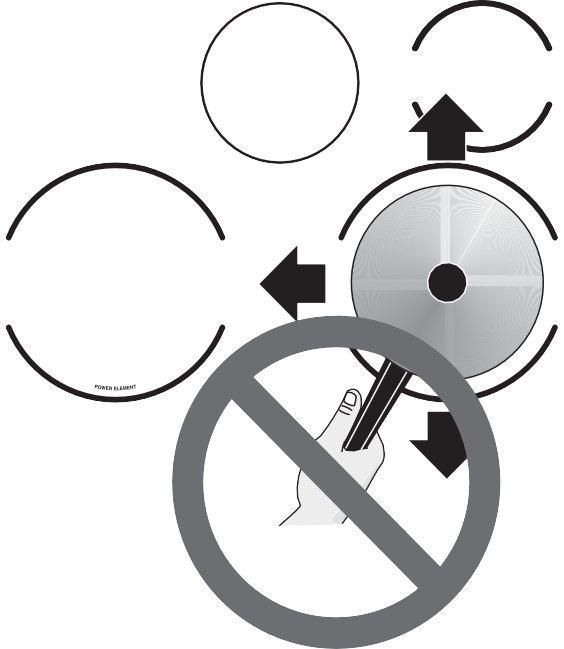
To get the best performance from your cooktop, start cooking on only one cooking zone. After the first piece of cookware has reached cooking tem- perature, then start cooking on the second cooking zone.
Setting the Timer
The cooktop has a timer function to remind you when food has been cooking for a specified amount of time.

To set the timer:
- Press the Timer On/Off key to activate the timer. The timer will show “00” flashing.
- Press + and – to set the desired number of minutes. The flashing will stop. You can press and hold the + or – key to change the number of minutes faster.
The timer will start counting down, and a tone will sound when the specified time has elapsed. Press the +, the -, or the Timer On/Off key to stop the signal.At any time, you can adjust the remaining time with the + and – keys.At any time, you can deactivate the timer by press- ing the Timer On/Off key.
Important: When the timer stops or the tone sounds, the cooking zones will continue to operate. The timer does not affect the cooking zone settings in any way.
Lock or Unlock the Cooktop
The lock function deactivates most of the controls on the cooktop to keep cooking zones from being changed by accident or to keep children from acti- vating the cooktop.
To lock the controls while cooking:
- Set the cooking zones to the desired settings.
- Press the Lock key.
To unlock the controls, press the Lock key again.
Even while the controls are locked, you can turn a cooking zone off using its On/Off key.
To set the lock for child safety:
- Press the Power key to turn the cooktop on.
- Press the Lock key and hold it for 4 seconds. The lock will activate, and L will display in all of the cook zone setting indicators.
- Press the Power key to turn the cooktop off.
When the cooktop is locked for child safety, two op- tions are available to unlock it. Complete unlock:
- Press the Power key to turn the cooktop on.
- Press the Lock key and hold it for 4 seconds. The lock will deactivate.
- Press the Power key to turn the cooktop off.
Temporary unlock:
- Press the Power key to turn the cooktop on.
- Hold the lock key for 4 seconds.
- Set the cooking zones.
- When the cooking process is finished and the cooktop is turned off, the Lock function will be still active.
Key-Stuck Function
The cooktop has an automatic switch-off function to prevent unintended operation that could cause the cooktop to increase zone settings or activate zones unattended.
Examples could include a child playing with the controls, a pet stepping on the control, or an object like a spoon left on the control.
If a control key is held for more than 10 seconds, the cooktop will sound an alert of 5 tones. If the key is still held after the alert sound, the cooktop will switch off. This function will also activate if the a zone slider is continually held or adjusted for 10 seconds.
Home Canning
Be sure to read and observe all the following points when home canning with your appliance. Check with the USDA (United States Department of Agriculture) Web site and be sure to read all the information they have available as well as follow their recommendations for home canning procedures.
- Use only a completely flat bottom canner with no ridges that radiate from the bottom center when home canning. Heat is spread more evenly when the bottom surface is flat. Use a straight- edge to check canner bottom.
- Make sure the diameter of the canner does not exceed 1 inch beyond the surface element markings or burner.
- It is recommended to use smaller diameter canners on electric coil and ceramic glass cooktops and to center canners on the burner grates.
- Start with hot tap water to bring water to boil more quickly.
- Use the highest heat setting when first bringing the water to a boil. Once boiling is achieved, re- duce heat to lowest possible setting to maintain that boil.
- Use tested recipes and follow instructions care- fully. Check with your local Cooperative Agricultural Extension Service or a manufacturer of glass jars for the latest canning information.
- It is best to can small amounts and light loads.
- Do not leave water bath or pressure canners on high heat for an extended amount of time.
Care And Cleaning
Cooktop Maintenance
Consistent and proper cleaning is essential to main- taining your ceramic glass cooktop.
Prior to using your cooktop for the first time, apply a ceramic cooktop cleaning cream (available in most hardware, grocery, and department stores) to the ceramic surface. Clean and buff with a clean paper towel. This will make cleaning easier when soiled from cooking. Cooktop cleaning creams leave a pro- tective finish on the glass to help prevent scratches and abrasions.
Sliding pans on the cooktop can cause metal mark- ings on the cooktop surface. These marks should be removed immediately after the cooktop has cooled using cooktop cleaning cream. Metal marks can be- come permanent if not removed prior to future use.
Cookware (cast iron, metal, ceramic, or glass) with rough bottoms can mark or scratch the cooktop surface.
Do not:
- Slide anything metal or glass across the cooktop.
- Use cookware with dirt or dirt build up on the bottom; always use clean cookware.
- Use your cooktop as a cutting board or work surface in the kitchen.
- Cook foods directly on the cooktop surface with- out a pan.
- Drop heavy or hard objects on the ceramic glass cooktop; they may cause it to crack.

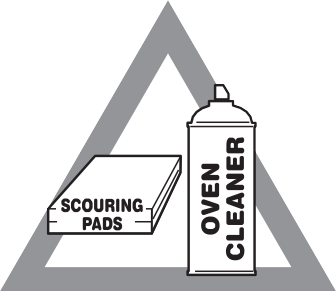
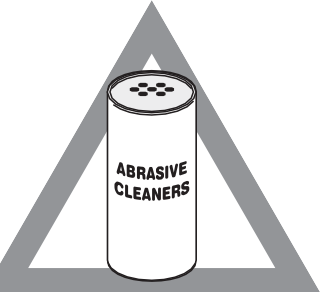
For light to moderate soil:
For light to moderate soil: Apply a few drops of cooktop cleaning cream directly to the cooktop. Use a clean paper towel to clean the entire cooktop sur- face. Make sure the cooktop is cleaned thoroughly, leaving no residue. Do not use the towel you use to clean the cooktop for any other purpose.
For heavy, burned on soil:
Apply a few drops of cooktop cleaning cream directly to the soiled area. Rub the soiled area using a non-abrasive cleaning tool, applying pressure as needed. Do not use the pad you use to clean the cooktop for any other purpose.
If soils remain, carefully scrape soils with a metal razor blade scraper, holding scraper at a 30 degree angle to the surface. Remove loosened soils with cooktop cleaning cream and buff the surface clean.
![]()
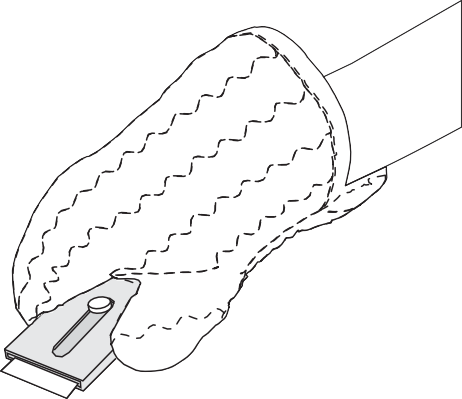
Solutions to Common Problems
Before you call for service, review the following list. It may save you time and expense. Possible solutions are provided with the problem listed
|
Problem |
Cause / Solution |
|
Entire appliance does not operate |
Appliance not connected. Make sure power cord is plugged properly into out- let. Check your fuse box or breaker box to make sure the circuit is active. Electrical power outage. Check house lights to be sure. Call your local electric company for service outage information. |
|
Cooktop Problems |
|
|
Problem |
Cause / Solution |
|
Cookware in the cooking zone is too hot or not hot enough. |
Incorrect surface control setting. Adjust power level setting. |
|
Cooking zone does not heat cookware. |
Be sure the correct surface control is turned on for the element needed. Incorrect cookware used. See “Using Proper Cookware” on page 9. Cookware is the wrong size or incorrectly positioned in the cooking zone. See “Pan Sensing” on page 10. |
|
Cooking zone does not heat evenly. |
Cookware is warped. Use only flat, evenly balanced cookware. Flat pans heat better than warped pans. Cookware materials and weight of the material affect heating. Heavy and medium-weight pans heat evenly. Because lightweight pans heat unevenly, foods may burn easily. |
|
Cooking zone control does not work |
More than one control was pressed at once. Make sure that when trying to set the control, nothing is touching another control. Water or soil on the control panel. Clean the control panel. |
|
Areas of discoloration with metallic sheen on cooktop surface. |
Mineral deposits from water and food. Remove them using cooktop clean- ing creme applied to the ceramic surface. Buff with a non-abrasive cloth or sponge. |
|
Scratches or abrasions on cooktop surface. |
Coarse particles such as salt or hardened soils between cooktop and cook- ware can cause scratches. Be sure the cooktop surface and bottoms of cook- ware are clean before use. Small scratches do not affect cooking and will become less visible with time. Cleaning materials not recommended for ceramic-glass cooktop have been used. Apply cooktop cleaning creme to the ceramic surface. Buff with a non- abrasive cloth or sponge. Cookware with a rough bottom was used. Use smooth, flat-bottomed cook- ware. |
|
Metal marks on the cooktop. |
Sliding or scraping of metal utensils on cooktop surface. Do not slide metal utensils on the cooktop surface. Apply cooktop cleaning creme to the ceramic surface. Buff with a non-abrasive cloth or sponge. For more information, see “Cooktop Cleaning” on page 18. |
|
Brown streaks or specks on cooktop surface. |
Boil overs stuck on the surface. When cooktop is cool, use a razor blade scraper to remove soil. For more information see “Cooktop Cleaning” on page 18. |
|
Cooktop Problems |
|
|
Problem |
Cause / Solution |
|
The number in the setting indicator is flashing. |
Incorrect cookware used. See “Using Proper Cookware” on page 9. Cookware is the wrong size or incorrectly positioned in the cooking zone. See “Pan Sensing” on page 10. |
|
The letter E appears in a setting indicator |
An error has occurred. This may happen because cookware has boiled dry. Remove cookware and turn off the cooktop. After 30 seconds, turn on the cooktop. If the cookware was the problem, E will no longer display. An error may occur because of water, oil, or food on the controls. Clean the control panel. Disconnect the power to the cooktop for a minute, then reconnect it. If the error still occurs, call an authorized dealer or service technician. |
|
The letter L appears in the setting indicators. |
The cooktop is locked. See “Lock or Unlock the Cooktop” on page 15. |
|
The cooktop deactivates A signal sounds when the cooktop is not operating |
There is an object on the controls. Remove the object. See “Key-Stuck Func- tion” on page 16. |
|
The Hot Cooktop warning did not come on |
The cooktop did not get hot enough to activate the warning. If the cooktop was running long enough for the surface to get hot, call an authorized dealer or service technician. |
|
The control area becomes hot |
The cookware is too large or too close to the controls. Put large cookware on a rear zone if possible. |
|
A dash (-) shows in the setting indicator |
This zone cannot be used until the cooktop is turned off, then turned on. The other zones are still operable. |
WARRANTY
How long is the IKEA guarantee valid?
This guarantee is valid for five (5) years from the original date of purchase of Your appliance at IKEA, un- less the appliance is named LAGAN or TILLREDA in which case two (2) years of guarantee apply. The origi- nal sales receipt is required as proof of purchase. If service work is carried out under guarantee, this will not extend the guarantee period for the appliance.
Who will execute the service?
IKEA “Service Provider” will provide the service through its own service operations or authorized service partner network.
What does this guarantee cover?
The guarantee covers faults of the appliance which have been caused by faulty construction or material faults from the date of purchase from IKEA. This guarantee applies to domestic use only. Some exceptions not guaranteed are specified under the headline “What is not covered under this guarantee?” Within the guarantee period, the costs to remedy the fault (e.g., repairs, parts, labour and travel) will be covered, pro- vided that the appliance is accessible for repair without special expenditure. On these conditions
the local regulations are applicable. Replaced parts become the property of IKEA.
What will IKEA do to correct the problem?
IKEA appointed Service Provider will examine the product and decide, at its sole discretion, if it is covered under this guarantee. If considered covered, IKEA Service Provider or its authorized service partner through its own service operations, will then, at its sole discretion, either repair the defective product or replace it with the same or a comparable product.
What is not covered under this guarantee?
- Normal wear and tear.
- Deliberate or negligent damage, damage caused by failure to observe operating instructions, incorrect installation or by connection to the wrong voltage, damage caused by chemical or electrochemical reac- tion, rust, corrosion or water damage including but not limited to damage caused by excessive lime in the water supply, damage caused by abnormal environmental conditions.
- Consumable parts including batteries and lamps.
- Non-functional and decorative parts which do not affect normal use of the appliance, including any scratches and possible colour differences.
- Accidental damage caused by foreign objects or substances and cleaning or unblocking of filters, drain- age systems or soap drawers.
- Damage to the following parts: ceramic glass, accessories, crockery and cutlery baskets, feed and drainage pipes, seals, lamps and lamp covers, screens, knobs, casings and parts of casings. Unless such damages can be proved to have been caused by production faults.
- Cases where no fault could be found during a technician’s visit.
- Repairs not carried out by our appointed service providers and/or an authorized service contractual partner or where non-original parts have been used.
- Repairs caused by installation which is faulty or not according to specification.
- The use of the appliance in a non-domestic environment i.e. professional use.
- Transportation damages. If a customer transports the product to his home or another address, IKEA is not liable for any damage that may occur during transport. However, if IKEA delivers the product to the customer’s delivery address, then damage to the product that occurs during this delivery will be covered by IKEA.
- Cost for carrying out the initial installation of the IKEA appliance. However, if an IKEA appointed Service Provider or its authorized service partner repairs or replaces the appliance under the terms of this guar- antee, the appointed Service Provider or its authorized service partner will reinstall the repaired appli- ance or install the replacement, if necessary.
How country law applies
The IKEA guarantee gives you specific legal rights, and you may also have other rights which vary from state to state or jurisdiction to jurisdiction. However these conditions do not limit in any way consumer rights described in the local legislation.
Area of validity
For appliances which are purchased in United States or Canada, or moved to one of the mentioned coun- tries, the services will be provided in the framework of the guarantee conditions normal in the specified country.
An obligation to carry out services in the framework of the guarantee exists only if the appliance complies and is installed in accordance with:
- the technical specifications of the country in which the guarantee claim is made;
- the Assembly Instructions and User Manual Safety Information.
The dedicated AFTER SALES for IKEA appliances
Please don’t hesitate to contact IKEA appointed After Sales Service Provider to:
- make a service request under this guarantee;
- ask for clarifications on installation of the IKEA appliance in the dedicated IKEA kitchen furniture;
- ask for clarification on functions of IKEA appliances.
To ensure that we provide you with the best assistance, please read carefully the Assembly Instructions and/or the User Manual before contacting us.
How to reach us if you need our service
In order to provide you a quicker service, we recommend to use the specific phone numbers listed on this manual. Always refer to the numbers listed in the booklet of the specific appliance you need an assistance for.
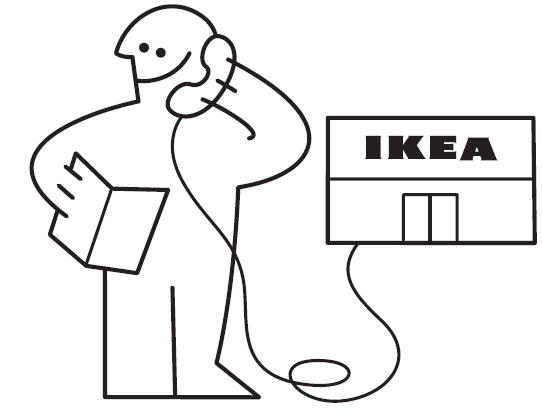
Phone number: (833) 337-4006Opening hours: Monday – Friday8:30 am – 8:00 pm EST
Please also always refer to the IKEA article number (8 digit code) placed on the rating plate of your appli- ance.
SAVE THE SALES RECEIPT!
It is your proof of purchase and required for the guarantee to apply. The sales receipt also reports the IKEA name and article number (8 digit code) for each of the appliances you have purchased.
Do you need extra help?
For any additional questions not related to After Sales of your appliances please contact your nearest IKEA store call centre. We recommend you read the appliance documentation carefully before contacting us.
IKEA SAMFALLD Installation Instruction Manual – IKEA SAMFALLD Installation Instruction Manual –
[xyz-ips snippet=”download-snippet”]

